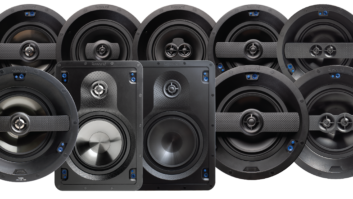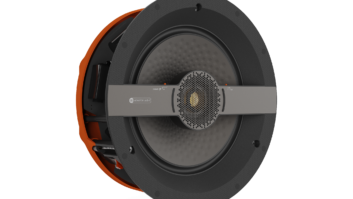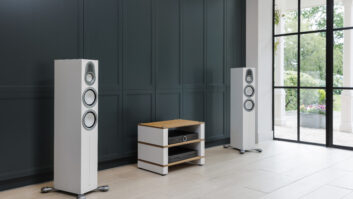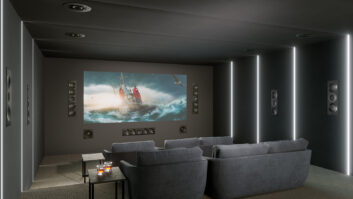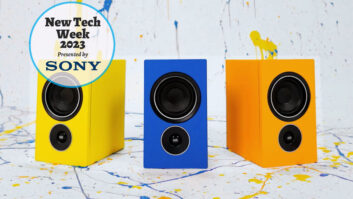Kudos: Terrific redesign; simplified lineup; larger woofers in the same size; IMS-4 is a great whole-home solution
Concerns: Higher price; wish smart IA-series amp had more channels
While we’ve come to expect new TV models practically every year and updated receivers every two to-three years, products like speakers have a much longer life cycle. And few products see refreshes as infrequently as architectural audio speakers.
Case in point: Some of you reading this weren’t alive when some of Monitor Audio’s recent Core and Controlled Performance Series speakers were introduced nearly 20 years ago!
While speaker technology doesn’t change as rapidly as other things, 20 years is a long time in anyone’s book, and Monitor Audio saw this as the perfect time for a complete overhaul — and simplification — of its architectural speaker line, resulting in the new Creator Series.

According to Monitor Audio, “The series is designed and engineered to support the demands of the installer: reliability, flexibility, usability, intuitive functionality, easy integration, superior build quality, and outstanding sound performance.”
The company also tapped into its “Monitor Audio Partner Program” (MAPP) and listened to feedback from integrators in the field, which resulted in simplifying the product range and accessory offerings, and more clearly defining performance levels.
To experience the full range, Monitor Audio sent me three in-ceiling models, one from each tier, along with the flagship in-wall model. I mean, when a company offers to send you their best, you just smile and say, “Yes, please!”
Along with the speakers, Monitor Audio sent its IA125-4 custom-installation DSP amplifier and its IMS-4 4-zone BluOS streamer to create an end-to-end Monitor Audio system.
Meet the Creators
Michael Hedges, Monitor Audio’s technical director, says, “We’ve carefully reviewed our architectural offering, simplified it, and focused on key models that we know work for installers. The Creator Series benefits from a clear performance-led tiered system across new models, so it’s easy to understand performance versus budget. It has also allowed us to incorporate high-performance features…ensuring each model offers best-in-class sound and builds on the previous tier in terms of features and outright performance.”
Gone are any confusing names and model numbers; instead the Creator Series has a much-simplified naming structure. You have a designation for install type, C (in-ceiling/round) and W (in-wall/rectangular), tier (1 good, 2 better, 3 best), cut-out size (S, M, L), and technology (i.e., CP for controlled performance). The result is a total of 14 new in-ceiling and five in-wall speakers.

This streamlines existing offerings, removing/replacing 31 previous models from the Slim, CP, CORE, and PRO lines. (Some models, such as the C165, C180, W165, and W180 will remain in the line.)
In the C models, there are three Tier 1 speakers, seven Tier 2 speakers, and four Tier 3 models. Regardless of tier, all S speakers feature 5-inch drivers and a 6.75-inch cutout, M feature a 7-inch driver and an 8.35-inch cutout, and L speakers benefit from a 9-inch woofer and 9.75-inch cutout.
If you noticed that the mid sizes step up from a traditional 6.5-inch to a 7-inch woofer and that the large goes from an 8-inch to a 9-inch, well spotted. However, rest assured that these speakers will still fit into the same cutout size as the previous speakers, allowing you to easily upgrade performance and bass output without doing any cutting.
All Tier 1 speakers are 2-way models with a C-CAM mid-bass driver and a 1-inch C-CAM tweeter featuring a new Uniform Dispersion (UD) Waveguide that produces greater dispersion. Because of this, none of the Creator Series speakers feature pivoting tweeters. Additionally, this is said to improve time alignment, allowing the wave from the tweeter and drivers to reach the listener simultaneously and increase tweeter sensitivity above 10 kHz. Monitor Audio states that Tier 1 is designed “to marry affordable price points with solid, reliable performance.”
Tier 2 steps up to Monitor Audio’s Rigid Surface Technology (RST) II drivers based on its Silver 7G speaker lineup, which has a more rigid profile with a new hexagonal dimpled structure to maximize driver bandwidth, improve linearity, and deliver smoother crossover with the tweeter. Tier 2 also benefits from an upgraded UD Waveguide II, which further improves off-axis listening and adds adjustment for boundary correction and high-frequency cut/boost.
The Tier 2 series also adds two Controlled Performance (CP) models with a built-in, fully sealed backbox for locations where you need to minimize sound leakage to other areas.
Also new in the Tier 2 series is a T2X model in both M and L sizes. This problem-solver is an amalgamation of previous T2 and FX models, offering three different operation modes: Cinema Mono FX (di-pole playback with tweeters out of phase), Mono Wide Dispersion (bi-pole playback with tweeters in phase), and Single Speaker Stereo (two binding posts accept connection to left/right amp channels). This speaker could be ideal for use as a rear surround, in compact spaces where two speakers aren’t practical, or in large areas where maximum coverage is needed.

The flagship Tier 3 series has four models, including one CP, all of which are three-way. There is no small-sized Tier 3 model. These speakers step up to drivers based on those in Monitor Audio’s new Platinum Series 3G speakers, including new Rigid Diaphragm Technology (RDT) III bass drivers and new Inverted Dual Concentric (IDC) II coaxial mid/tweeter drivers. These are a ground-up redesign, now featuring a larger voice coil to ensure the UD Waveguide II can be used to control the high-frequency directivity. Monitor Audio claims this design is effectively a point source that creates an exceptionally large soundstage. Tier 3 models also get separate MF and HF boost/cut controls along with boundary compensation.
Tier 3 also adds a new A model, which stands for angled. This has a fixed-angle IDC II driver that delivers a “spotlight” effect, directing mid- and high-frequency sounds to the listening area. These drivers, set at 25 degrees, are said to be ideal for use as in-ceiling front LCR speakers where in-walls aren’t possible, achieving greater focus across the full frequency range into the listening area.
In the W – in-wall – series, there are two Tier 1 models, two Tier 2 models, and one Tier 3. All of the W series speakers are M-sized, which is a 7.8- x 20.75-inch cutout that fits between Monitor Audio’s current small and large sizes. The great thing here is you don’t need to worry about different cutouts for different models, and if a customer wants to make an upgrade down the road, even the very best speaker will fit into the cutout of the entry-level model! (Do be aware that the depth varies; however, all should fit in a standard 2×4 wall construction.)
Beyond the most entry-level W1M-E, which features just a single 5-inch mid/bass driver, all W speakers feature dual 5-inch bass drivers but utilize different/improved technologies as you move up the line.
More Reviews: Juke Audio Juke+ Whole-Home Audio Streamer
Tier 1 models are 2-way with a C-CAM mid/bass driver, Tier 2 models are 3-way with RST II bass and midrange drivers, including one CP model, and the Tier 3 steps up to RDT III bass drivers and a C-CAM midrange. The Tier 3 speaker is also the only model to include a 1-inch Micro-Pleated Diaphragm (MPD) II, which was developed for Monitor Audio’s THX Certified Ultra Cinergy Cinema and is designed to deliver similar performance in a more compact form factor. This MPD II driver produces accurate, lifelike sound without distortion, “like a super-fast accordion.”
Both the Tier 2 and 3 speakers house the mid and tweeter in a rotatable pod, allowing it to be used horizontally, such as in center channel applications.
Monitor Audio has also used all-new crossovers designed for each model and Tier within the Creator Series that have been “optimized to deliver the best possible distribution of frequencies to the speakers,” guaranteeing “that each speaker’s drive units receive the most accurate frequency distribution,” with the quality of components and complexity of the crossovers increasing as you step up.
Be aware that the Creator Series has seen a pretty hefty price increase. The MSRP on the least expensive in-ceiling speaker, the C1S, is $375/ea., while the lowest-priced in-wall, the W1M-E, sells for $450/ea. No matter how great they sound, $750-900/pair at the most entry-level is not a small amount for some buyers, especially if you are talking about kitting out an entire house with audio. Tier 2 pricing starts at $550/ea. for the C2S, with the W2M selling for $900/ea. Perhaps the “sweet spot” of the line is the C2L, which gives great performance upgrades and fuller bass, at $700/ea. The flagship C3L sells for $1150/ea. with the specialty C3L-A at $1500/ea. and the W3M at $1600/ea.
To give that a little perspective, a great-sounding 5.0.4 home theater system utilizing five W3Ms at the listener level and four C3L’s overhead, would retail for $12,600 (at full MSRP) and deliver a fantastic sounding, fully discreet speaker system.
Install Friendly
There are two other new features important enough that I wanted to call them out in their own section.
First is a new Quik-Link terminal speaker wire connection that demonstrates how Monitor Audio thought about simplifying the install process. This is a removable terminal that lets you separately connect the speaker wires and then use two small N35 magnets to just snap and lock it back into place on the speaker. This simple little design improvement leads me to believe that the designer has actually been on top of a ladder trying to balance a speaker, wire stripper, and drill while making connections one-handed. Or, more likely, they listened to the feedback of their MAPP members and found a way to eliminate a pain point. While it might not “revolutionize the speed of install” as Monitor Audio claims, it definitely speeds up the process, but, more importantly, makes it easier and safer.

The other install improvement is a new Tri-Grip II dogleg. While you will likely only use/experience this once during the initial install, you’ll appreciate that it is considerably stronger and more reliable than previous designs. This features a dual-thread 4mm screw with a brass insert and a latch system that keeps the dogleg in home position while the speaker is being installed or removed. There are also cushioned pads that soften impact against the drywall, providing a firmer and more secure grip. But should you ever need to remove the speaker, you’ll value how this design also keeps the dogleg from not operating or completely unscrewing/disassembling.
First Impressions
Do you want to know my honest-to-God first impression about these products? As I was carrying box after box of brand-new gear into my house, and opening all this brand-new kit, my first impression was, “Damn! You’re getting paid to listen to all this brand-new, top-shelf gear. You lucky bastard!”
Because I don’t believe in beating around the bush, I went straight for the best-of-the-bunch, the W3M. From that model number, you can discern it is in-wall (W), the top of the performance tier (3), and Medium-sized (M).
Pulling the W3M from its packaging, it was immediately apparent the quality and build construction that went into it with the speaker weighing in at nearly 10.5 pounds. I’ve installed dozens (hundreds?) of in-wall speakers, and from the rigidity of the baffle to the driver design, to the quality of components, it was clear this was a flagship offering. Not the heaviest I’ve ever installed, but certainly up there. And with the greenish tint of the drivers and MPD II tweeter, it just looked cool.
Next up I unboxed the C3L and again was floored with the heft and top-shelf design and build of this speaker. This bad boy weighs in at 11 pounds, and I’m honestly not sure I’ve felt an in-ceiling speaker this heavy. This speaker steps up to a 9-inch woofer, and on the ground next to the M-sized models, it certainly looks bigger; however, my impression of the size difference changed once I got them installed.
Monitor Audio is looking to create clear performance steps with each Tier, and while I opened them in reverse order, it was clear I was stepping down each time. As a medium-sized speaker, stepping down to a 7-inch driver, the C2M was not just smaller, but clearly featured less-complex drivers and design, while the C1M again stepped down in hardware and features. You could see the visual differences between the UD Waveguide I and II, as well as the step-ups in driver technology. This isn’t a knock, but just an assertion that the quality and performance steps Monitor Audio was looking to achieve with the Creator Series are clear and obvious.
Another subtle detail you might easily overlook is that all the Creator Series grilles aren’t like typical speaker grilles with just a ton of small, circular holes. Instead, they all feature a new hex pattern that has been optimized to offer the least amount of interference to high-frequency signals. Monitor Audio claims the improvement is ±15 degrees better coverage over previous architectural speaker grilles.
Next, I unboxed the IA125-4, a compact yet powerful amplifier designed with the CI channel in mind. This network-connected amp packs four channels of 125 watts of power into a half-width 1U form factor. The amp can also be used in power sharing or 70-volt mode for 250 watts x 2. It has four RCA analog inputs, terminals for connecting four XLR inputs, a coaxial digital in/out, and a configurable GPIO (General Purpose Input/Output) connection. Further, it has a ton of DSP onboard that offers an amazing amount of versatility and configurability to fine-tune the audio in each space. You can also upload EQ curves designed to work with a host of Monitor Audio speakers, including the Creator models. If you need more power — I didn’t — you could step up to the bigger brother, IA750-4, which has 750 watts x 4 that can be bridged to 1500 watts x 2! This is a super flexible amplifier whose only real shortcoming is that it only has four channels. (Monitor Audio does make a 12-channel amplifier — the IA60-12 — but it doesn’t have any of the network or DSP capabilities of the others.)
Finally, I got to the streamer, the IMS-4. I’m familiar with NAD’s BluOS operating system and I’m a big fan. I love the app and I love the performance. This piece is tailor-made for the CI channel, incorporating four BluOS zones into a single chassis and giving you terrific connection flexibility with analog, Toslink optical, and coaxial digital outputs for each zone. It also offers expansion with RCA analog and Toslink optical inputs, along with a 12-volt trigger in/out and a rear panel IR input. The IMS-4 also supports Apple AirPlay2 and Tidal Connect and includes integration modules for use with Crestron, Control4, and RTI. Imagine having four Bluesound Nodes in a single, compact 1U chassis that only requires a single power and Ethernet connection, with rich integration with your preferred control system, and the ability to play true 192/24 and MQA high-resolution audio files — that’s the IMS-4.


Setup
My bedroom and bathroom had existing speakers; some Russound 6.5-inch models in my bedroom and some Sonance 6.5-inch in my bathroom, so I was going to put to test the claim that the new 7-inch woofers would fit into existing cutouts. After getting the other speakers out, I put the C2Ms in my bathroom and the C1Ms in my bedroom and, sure enough, they slipped right into the existing holes.
This was also my first chance to try out the Quik-Link in an actual install, and I’ve got to say, it’s great! I’m not the most confident guy standing on top of a ladder, but with Quik-Link, I made my connections, then grabbed the speaker with one hand and snapped the Quik-Link into place with the other, pressed it up into the ceiling, and screwed it into place. I also found the new Tri-Grip II dogleg worked as promised, offering smooth, controlled travel till the speaker locked into place. It also worked perfectly well in reverse, letting me unscrew and remove the speaker without any hassles.

After listening to the C1Ms in my bedroom for a few weeks, I went for the big upgrade, removing them and cutting in the C3Ls. I liked how the supplied cutout template has adhesive backing so you can stick it onto the ceiling to trace around if desired; a small thing, but a nice touch. I also really appreciated how the Quik-Link connector is the same across all speakers, letting you just unplug and reconnect to the new model if you upgrade.
Interestingly, expanding the cutout size only added about 0.7 inches all around, and once the speakers were installed and grilled up, they honestly didn’t look much bigger.
I installed the W3M’s into my prefabricated speaker testing walls, letting me position them for an ideal stereo soundstage. I used the IA125-4 and IMS-4 to drive the W3Ms, while my existing Control4 and Triad system powered the C models.
Performance
Because I knew I’d be replacing/upgrading them, I started listening to the C1Ms in my bedroom, and what I noticed right away was the significant improvement in bass output. Monitor Audio rates these speakers as –6 dB at 35 Hz, and I believe it. Whether this was due to the larger 7-inch driver, the better driver technology, or more likely a combination of both, this was a noticeable improvement over the previous speakers in my bedroom in the same form factor. And they passed my “deep note” test from The Crystal Method’s “High Roller,” delivering nice depth to the big bass drop that comes in at 1:07. Beyond just the low-end bass capability, it gave real texture and layers to bass such as Flea’s work on “Soul to Squeeze.”
As promised, the new UD Waveguide delivered great off-axis listening. Even when sitting almost directly under one of the speakers, I was still able to clearly discern audio from the second speaker, making for a nice, room-filling, stereo presentation. If anything, the Core 1 speakers lean a bit forward in the midrange, especially at louder volumes.
More Reviews: Theory Audio Design Surround Audio System
Stepping up to the C2Ms in my bathroom, what I mostly noticed was an uptick in mid- and high-frequency detail and resolution. Sounds just had a bit more sparkle and clarity in that range, clearly noticeable when I’d have the same content playing and walking between the rooms/speakers.
The C3 Series is certainly meant for areas where music is going to be enjoyed rather than just something that is happening, and moving up to the C3Ls in my bedroom delivered another performance leap. Between the improved driver technology and 3-way design, these speakers produce a fuller and richer sound. I was expecting a decent bass upgrade from the L speakers stepping up to the 9-inch driver, but that wasn’t really the case, which I’ll explain more in a bit. However, the overall sound quality was just fantastic — up there with the best in-ceiling speakers I’ve heard, delivering crystalline detail along with big sound. These are now speakers where I would go into my room to actually listen to music instead of it just being something playing in the background.
As great as the C3Ls sound, the W3Ms with the MPD II transducer raised detail to the next level. Also, there’s something inherently more “musical” about the soundstage being in front of you from an in-wall versus above you from an in-ceiling. But the high-frequency clarity of the W3M just makes you want to listen for hours. You can practically hear the spice shimmering amidst the sand grains blowing in the room in Hans Zimmer’s Dune 2 soundtrack, and the sudden percussion attack that happens around 3:30 into “A Time of Quiet Between the Storms” will make you jump at the volume!
The W3M’s mid- and high-frequency drivers just deliver such texture to the music. Delicate sounds like brush strokes and cymbal taps shine, while trumpet blasts have weighty authority. They also wonderfully re-create the spaciousness of the recording space, giving the right amount of reverb to Rebecca Pidgeon’s voice and instrumentation on “The Raven.”
They can also play effortlessly at loud volumes. They are rated to handle up to 225 watts and have a maximum peak SPL of 122 dB (Z-rated), and I was able to easily hit 95+ dB at my listening position about 10 feet from the speakers without any noticeable strain from the speakers.
If the W3Ms have any limitations, it’s in their low-end, where they only go down to a rated 45 Hz. While this is acceptable for most music listening, my “big note” drop from “High Roller” just doesn’t hit with enough weight, and you’d definitely want to pair them with a good subwoofer for movie-watching.
Monitor Audio’s published specs for the Creator Series are a case where the numbers don’t tell the whole story. For example, both the 7-inch C3M and the 9-inch C3L are rated down to 45 Hz. You’d surely think the nine could play lower. And even more confounding, the 5-inch C1S — the smallest, most entry model —is rated down to 40 Hz. How a 5-inch can out-bass a 9-inch doesn’t make any sense to me, especially when both the C1L and C2L are rated down to 30 Hz.
According to Monitor Audio’s engineers, “The different frequencies come from the measured –6 dB points of the speakers, but this simple figure does not explain the roll-off shape. Tier 2 utilizes RST II, which is lighter than the RDT cones used in Tier 3. Tier 3 also has higher force factor motor units. This design choice leads to a very damped response for Tier 3, which results in a gentle roll-off in the bass. However, in the Tier 1 and 2 drivers the damping isn’t as high, so this has a very slight rise before then rolling off faster than Tier 3.”
Having said that, it sure sounds like the C3L plays lower than 45 Hz, and I never noticed any bass discrepancies between it and the C2M located in my adjacent bathroom, though they are massively different listening environments.
With the Creator Series, Monitor Audio has effectively relaunched its architectural speaker lineup, and they’ve done it in a terrifically smart way. From their simplified lineup and naming scheme to consistent sizing, to clear performance steps, to improved installation, the Creator Series offers something that will excite nearly everyone.
800-667-6065; MONITORAUDIO.COM
Product Specs:
- Creator Series includes 14 in-ceiling (C) and 5 in-wall (W) speakers
- Simplified S (small), M (medium), and L (large) sizing offers consistent sizing throughout all models
- All speakers include new removable Quik-Link speaker connections
- Tier 1 includes three C and two W models; all 2-way featuring C-CAM mid-bass driver and C-CAM tweeter
- Tier 2 includes five C and two W models; all C models are 2-way featuring RST II mid-bass driver and C-CAM tweeter; W models are 3-way featuring dual 5-inch RST II bass driver, 3-inch RST II midrange, and 1-inch C-CAM tweeter
- Tier 3 includes four C and one W model; all C models are 3-way featuring RDT III bass driver, IDC II midrange, and IDC II tweeter; W model is 3-way featuring dual 5-inch RDT III bass driver, 3-inch C-CAM midrange, and MPD II transducer
Cutout Dimensions:
- S – 6.75 inches
- M – C Series: 8.375 inches; W Series: 7.81 x 20.75 inches
- L – 9.75 inches
